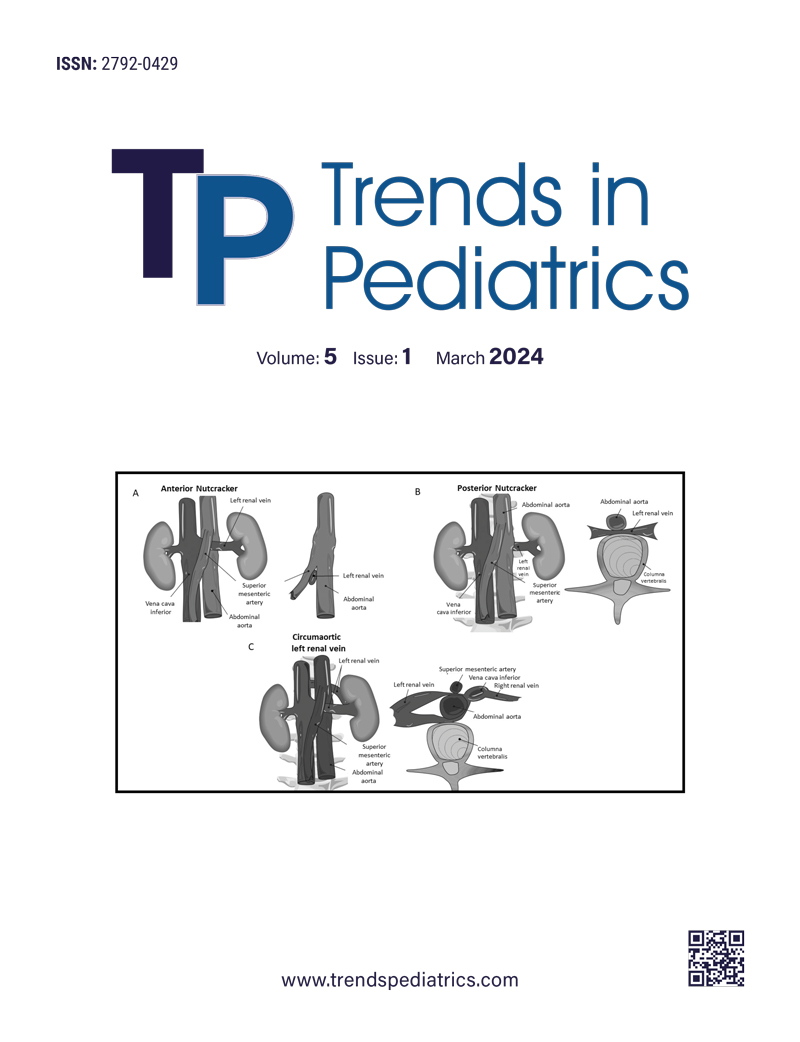Abstract
Objective: Very few studies have examined the risk factors for developing tolerance to food allergy in infants with atopic dermatitis (AD). To understand the risk factors for developing tolerance to food allergy in the first year in infants with atopic dermatitis and food allergy coexistence.
Methods: Ninety-three infants were included in this retrospective study. Food allergy was detected using food-specific IgE, skin prick, and oral food challenge tests. The severity of the disease was evaluated using Scoring Atopic Dermatitis (SCORAD). Demographic parameters were recorded from medical records.
Results: The rate of patients who tolerated food allergy in the first year was 61 (65.6%). The median age to tolerate food allergy was 12 (6-18 months). According to the SCORAD, 8 (8.6%) patients had mild, 50 (53.8%) had moderate AD, and 35 (37.6%) had severe AD. The median SCORAD value was 45.2 (35.2-54.6). There was no difference between the groups who tolerated food allergy and those who could not at the first age of life in terms of age, gender, gestational week, maternal age, and familial atopy history (p>0.05 for all). Egg allergy [p=0.035; OR:6.623 (CI:0.996-44.043)], parental atopy [p=0.024. OR:2.450 (CI:0.699-23.056], and AD severity [p=0.030. OR:1.240 (CI:1.001-22.105)] emerged as statistically significant variables at potential risk factors for food allergy intolerance in the first year.
Conclusion: Egg allergy, parental atopy, and severity of atopic dermatitis emerged as potential risk factors for intolerance to food allergy in the first year of life in infants with atopic dermatitis and food allergy coexistence.
Keywords: atopic dermatitis, allergy, cow's milk, egg, food allergy, tolerance
Copyright and license
Copyright © 2024 The author(s). This is an open-access article published by Aydın Pediatric Society under the terms of the Creative Commons Attribution License (CC BY) which permits unrestricted use, distribution, and reproduction in any medium or format, provided the original work is properly cited.
How to cite
References
- de Benedictis FM, Franceschini F, Hill D, et al. The allergic sensitization in infants with atopic eczema from different countries. Allergy. 2009;64:295-303. https://doi.org/10.1111/j.1398-9995.2008.01779.x
- Schneider L, Tilles S, Lio P, et al. Atopic dermatitis: a practice parameter update 2012. J Allergy Clin Immunol. 2013;131:295-9. https://doi.org/10.1016/j.jaci.2012.12.672
- Caubet JC, Eigenmann PA. Allergic triggers in atopic dermatitis. Immunol Allergy Clin North Am. 2010;30:289-307. https://doi.org/10.1016/j.iac.2010.06.002
- Fishbein AB, Silverberg JI, Wilson EJ, Ong PY. Update on Atopic Dermatitis: Diagnosis, Severity Assessment, and Treatment Selection. J Allergy Clin Immunol Pract. 2020;8:91-101. https://doi.org/10.1016/j.jaip.2019.06.044
- Boguniewicz M. Atopic dermatitis: the updated practice parameter and beyond. Allergy Asthma Proc. 2014;35:429-34. https://doi.org/10.2500/aap.2014.35.3798
- Eichenfield LF, Tom WL, Chamlin SL, et al. Guidelines of care for the management of atopic dermatitis: section 1. Diagnosis and assessment of atopic dermatitis. J Am Acad Dermatol. 2014;70:338-51. https://doi.org/10.1016/j.jaad.2013.10.010
- Sampson HA. The evaluation and management of food allergy in atopic dermatitis. Clin Dermatol. 2003;21:183-92. https://doi.org/10.1016/s0738-081x(02)00363-2
- Ertam İ, Su Ö, Alper S, et al. The Turkish guideline for the diagnosis and management of atopic dermatitis-2018. Turkderm Turkish Arch Dermatology Venereol. 2018;52:6-23. https://doi.org/10.4274/turkderm.87143
- Dermatitis AT. Asthma Allergy Immunology. 2018.
- Sehgal VN, Jain S. Atopic dermatitis: clinical criteria. Int J Dermatol. 1993;32:628-37. https://doi.org/10.1111/j.1365-4362.1993.tb04015.x
- Severity scoring of atopic dermatitis: the SCORAD index. Consensus Report of the European Task Force on Atopic Dermatitis. Dermatology. 1993;186:23-31. https://doi.org/10.1159/000247298
- Gulec Koksal Z, Uysal P. Beyond the Skin: Reduced Lung Function Associated With Atopic Dermatitis in Infants. J Allergy Clin Immunol Pract. 2023;11:2839-47. https://doi.org/10.1016/j.jaip.2023.06.055
- Bindslev-Jensen C, Ballmer-Weber BK, Bengtsson U, et al. Standardization of food challenges in patients with immediate reactions to foods-position paper from the European Academy of Allergology and Clinical Immunology. Allergy. 2004;59:690-7. https://doi.org/10.1111/j.1398-9995.2004.00466.x
- Guttman-Yassky E, Diaz A, Pavel AB, et al. Use of Tape Strips to Detect Immune and Barrier Abnormalities in the Skin of Children with Early-Onset Atopic Dermatitis. JAMA Dermatol. 2019;155:1358-70. https://doi.org/10.1001/jamadermatol.2019.2983
- Yuksel H, Can D, Reisli I, et al. Characteristics and prognosis of childhood atopic dermatitis: a multicenter study in Turkey. Int Arch Allergy Immunol. 2010;152:362-7. https://doi.org/10.1159/000288289
- Ulutaş AP, Cengizlier MR, Özen AO, Saf C, Vitrinel A. Evaluation of Our Patients with Atopic Dermatitis. 2014:45:197-203.
- Papapostolou N, Xepapadaki P, Gregoriou S, Makris M. Atopic Dermatitis and Food Allergy: A Complex Interplay What We Know and What We Would Like to Learn. J Clin Med. 2022;11:4232. https://doi.org/10.3390/jcm11144232
- Eigenmann PA, Sicherer SH, Borkowski TA, Cohen BA, Sampson HA. Prevalence of IgE-mediated food allergy among children with atopic dermatitis. Pediatrics. 1998;101:E8. https://doi.org/10.1542/peds.101.3.e8
- Strömberg L. Diagnostic accuracy of the atopy patch test and the skin-prick test for the diagnosis of food allergy in young children with atopic eczema/dermatitis syndrome. Acta Paediatrica. 2002;91:1044-9. https://doi.org/10.1111/j.1651-2227.2002.tb00097.x
- Martin PE, Eckert JK, Koplin JJ, et al. Which infants with eczema are at risk of food allergy? Results from a population-based cohort. Clin Exp Allergy. 2015;45:255-64. https://doi.org/10.1111/cea.12406
- Staden U, Rolinck-Werninghaus C, Brewe F, Wahn U, Niggemann B, Beyer K. Specific oral tolerance induction in food allergy in children: efficacy and clinical patterns of reaction. Allergy. 2007;62:1261-9. https://doi.org/10.1111/j.1398-9995.2007.01501.x
- Sampson HA. Food allergy: a winding road to the present. Pediatr Allergy Immunol. 2014;25:25-6. https://doi.org/10.1111/pai.12202
- Sampson HA. Food allergy. Part 1: immunopathogenesis and clinical disorders. J Allergy Clin Immunol. 1999;103:717-28. https://doi.org/10.1016/s0091-6749(99)70411-2
- Apfelbacher CJ, Diepgen TL, Schmitt J. Determinants of eczema: population-based cross-sectional study in Germany. Allergy. 2011;66:206-13. https://doi.org/10.1111/j.1398-9995.2010.02464.x
- Lowe AJ, Abramson MJ, Hosking CS, et al. The temporal sequence of allergic sensitization and onset of infantile eczema. Clin Exp Allergy. 2007;37:536-42. https://doi.org/10.1111/j.1365-2222.2007.02691.x
- Weidinger S, Novak N. Atopic dermatitis. Lancet. 2016;387:1109-22. https://doi.org/10.1016/S0140-6736(15)00149-X
- Illi S, von Mutius E, Lau S, et al. The natural course of atopic dermatitis from birth to age 7 years and the association with asthma. J Allergy Clin Immunol. 2004;113:925-31. https://doi.org/10.1016/j.jaci.2004.01.778
- Pascual CY, Crespo JF, Perez PG, Esteban MM. Food allergy and intolerance in children and adolescents, an update. Eur J Clin Nutr. 2000;54(Suppl 1):S75-8. https://doi.org/10.1038/sj.ejcn.1600990













